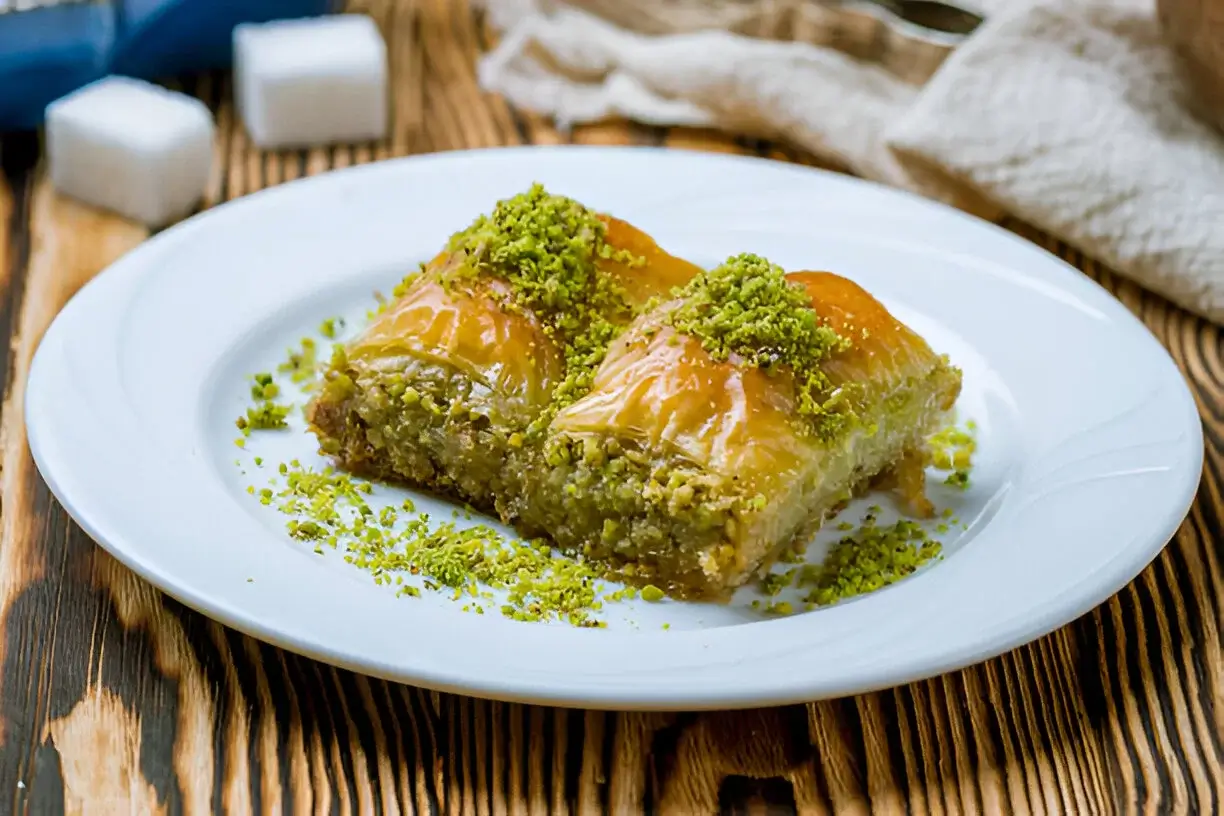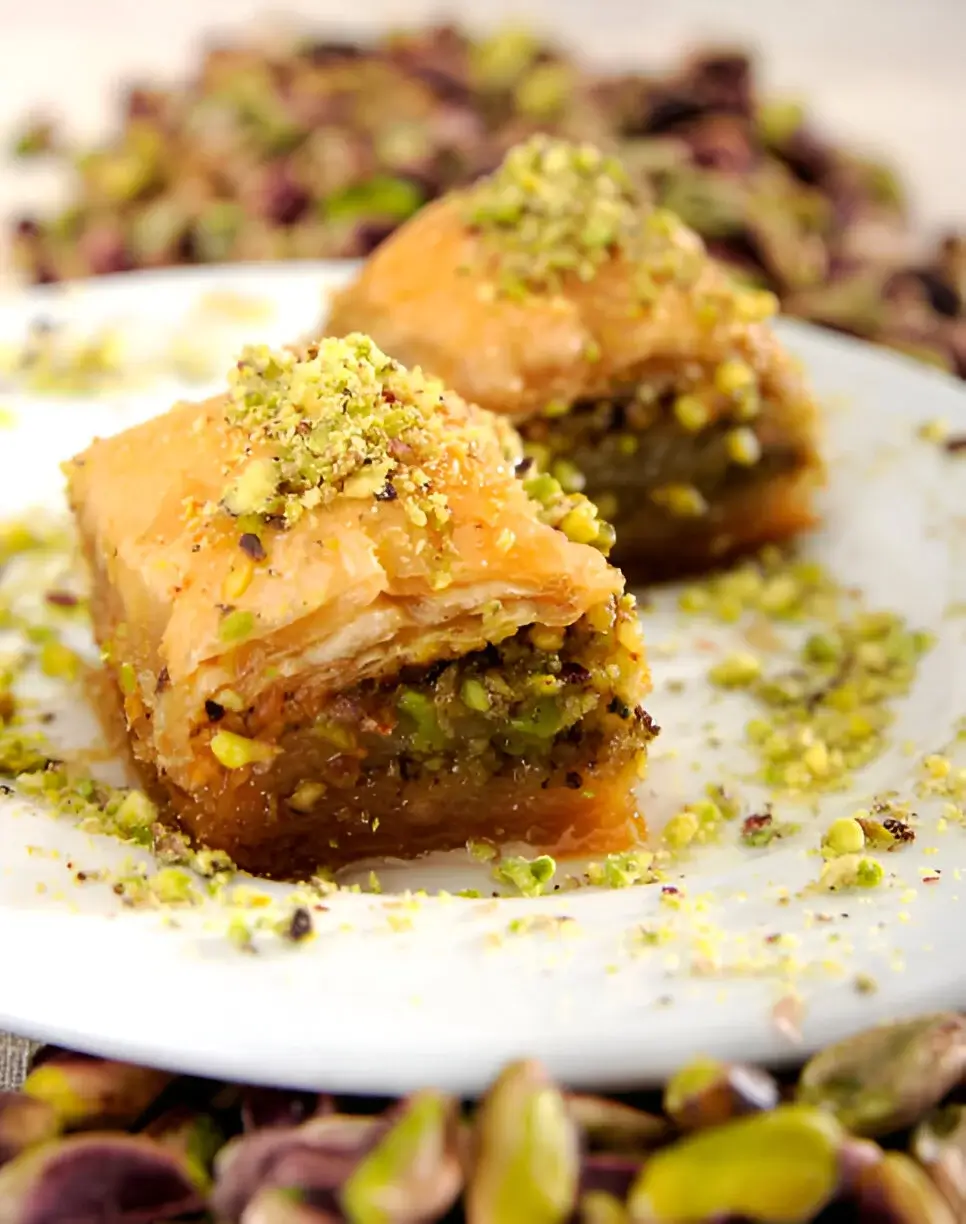What Makes Pistachios Special in Lebanese Desserts?
1. A Flavorful and Vibrant Ingredient
Pistachios hold a significant place in Lebanese cuisine, particularly in desserts, where they are celebrated for their distinct flavor, vibrant color, and rich texture. Often referred to as the “jewel of the kitchen,” these nuts elevate a wide range of sweet dishes, providing an exquisite balance of taste and visual appeal. Their unique nutty flavor perfectly complements other ingredients commonly found in Lebanese desserts, such as rose water, honey, and creamy fillings, creating layers of complexity that delight the palate.
2. The Perfect Crunch and Texture
The role of pistachios in Lebanese sweets extends beyond their taste. They add a delightful crunch that contrasts beautifully with the softness of ingredients like semolina, phyllo pastry, or custard. This interplay of textures is a hallmark of traditional Lebanese desserts, transforming them into more than just a treat—it’s a culinary experience.
3. A Feast for the Eyes
The striking green color of pistachios enhances the visual presentation of Lebanese confections. Whether sprinkled over desserts or used as a filling, pistachios lend an elegant and festive look, making these sweets a centerpiece for special occasions and celebrations.
4. A Symbol of Culture and Hospitality
Beyond their culinary attributes, pistachios symbolize luxury and generosity in Lebanese culture. They are deeply associated with hospitality, often served to guests as a sign of welcome. Traditional pistachio-based sweets are commonly prepared for religious holidays, weddings, and family gatherings, underscoring their cultural and social significance.
5. Packed with Nutritional Benefits
In addition to their flavor and cultural value, pistachios are a powerhouse of nutrients. Rich in heart-healthy fats, antioxidants, vitamins, and minerals, they make for a nutritious addition to any diet. Regular consumption of pistachios can support heart health, improve cholesterol levels, and provide essential nutrients, further solidifying their place in Lebanese gastronomy.
Essential Ingredients for This Recipe
To create authentic Lebanese pistachio desserts, understanding the essential ingredients is fundamental. Each component plays a significant role in achieving the distinctive flavors and textures that define these delightful treats.
1. Phyllo Pastry: The Flaky Foundation
Phyllo pastry, a finely layered dough, is a cornerstone of many Lebanese desserts. Light and crispy, it serves as a base or wrapper, lending a flaky texture that contrasts beautifully with rich, nutty fillings. Proper handling of phyllo dough is key to ensuring the delicate layers remain intact during preparation.
2. Pistachios: The Star Ingredient
Pistachios are the heart of Lebanese desserts, celebrated for their nutty flavor and vibrant green color. These nuts not only enhance the taste but also elevate the visual appeal of the desserts. For the best results, opt for high-quality pistachios—preferably raw and unsalted. Lightly toasting them before use can amplify their natural flavor, adding depth to your recipes.
3. Rose Water: The Floral Essence
Rose water is an essential ingredient in Lebanese cuisine, adding a subtle floral aroma and taste to desserts. This fragrant addition is what gives many Middle Eastern sweets their signature flavor. When choosing rose water, always opt for a pure and authentic product to avoid artificial tastes that could compromise the recipe.
4. Sugar and Sugar Syrup: The Sweet Touch
Sugar plays a vital role in balancing the nuttiness of pistachios and sweetening the overall dish. Traditional Lebanese desserts often use a combination of granulated sugar and sugar syrup. The syrup is typically infused with rose water or orange blossom water and is drizzled over layered pastries to enhance both moisture and sweetness.
5. Sourcing Authentic Ingredients
Finding high-quality ingredients is essential for achieving authentic flavors. Middle Eastern grocery stores are excellent places to source staples like phyllo dough, rose water, and raw pistachios. For those who can’t access these stores, online retailers often stock authentic Middle Eastern products. If necessary, certain substitutions can be made, but they may slightly alter the final taste and texture.
By carefully selecting and preparing these essential ingredients, you can craft authentic Lebanese pistachio desserts that capture the essence of this beloved cuisine.
Popular Lebanese Pistachio Desserts You Can Make at Home
Lebanon is renowned for its exquisite desserts, particularly those that showcase the rich flavor and versatility of pistachios. Among the most popular of these is the pistachio baklava. This traditional pastry features layers of delicate phyllo dough, each infused with a generous amount of crushed pistachios, butter, and spices, all drenched in a sweet syrup made from honey and sugar. The contrast between the crispy outer shell and the moist, nutty filling creates a delightful texture that is both satisfying and indulgent. Baklava is often served during celebrations and festive occasions, symbolizing hospitality and generosity in Lebanese culture.
Another beloved treat is pistachio maamoul, which are shortbread cookies typically filled with finely ground pistachios, sugar, and a hint of rose water. These cookies are often shaped into intricate patterns using a special mold, which adds to their appeal. With a crumbly yet tender texture, maamoul offers an exquisite balance of sweet and nutty flavors, making them a staple during holidays such as Eid and Easter. The preparation requires some finesse, as achieving the perfect dough consistency is essential for their melt-in-your-mouth quality.

Finally, pistachio clafoutis is another dessert worth exploring. While this dish has French origins, it has been embraced in Lebanese cuisine, often featuring a blend of local ingredients, including pistachios. Clafoutis is a baked custard-like dessert with a rich, creamy texture that encapsulates the nutty essence of pistachios. It can be served warm or chilled, making it a versatile choice for any occasion. Although it may seem intimidating to prepare, its simple ingredients and straightforward method make it accessible to home bakers of all levels.
Step-by-Step Recipe for Homemade Pistachio Baklava
Pistachio baklava is a beloved dessert that combines the rich flavors of nuts with flaky phyllo dough, resulting in an indulgent treat that is both sweet and savory. Follow this step-by-step guide to create this authentic Lebanese delight at home.
1. Gather Your Ingredients
To make homemade pistachio baklava, you’ll need the following:
- 1 package of phyllo pastry
- 1 cup of melted butter
- 2 cups of finely chopped pistachios
- 1 cup of granulated sugar
- 1 cup of water
- 1 tablespoon of lemon juice
Optional: Spices like cinnamon or alternative nuts such as walnuts for a personalized touch.
2. Prepare the Baklava Filling
- Preheat your oven to 350°F (175°C).
- In a mixing bowl, combine the finely chopped pistachios with 1/4 cup of sugar, ensuring the nuts are evenly coated.
- Set the filling aside while preparing the phyllo dough.
3. Layer the Phyllo Dough
- Once thawed, gently unroll the phyllo pastry and place a single sheet on a clean surface.
- Brush the sheet lightly with melted butter. Repeat this process for 5–6 sheets to form a sturdy base.
- Sprinkle a thin layer of the pistachio mixture evenly over the buttered phyllo.
- Continue layering by adding 2 sheets of buttered phyllo, followed by a layer of the pistachio mixture.
- Repeat until all the pistachios are used, finishing with several more layers of buttered phyllo on top.
4. Cut and Bake the Baklava
- Use a sharp knife to cut the assembled baklava into diamond or square shapes.
- Place the dish in the preheated oven and bake for 40–45 minutes, or until the top is golden brown.
5. Make the Syrup
- While the baklava bakes, prepare the traditional syrup.
- In a saucepan, combine the remaining sugar, water, and lemon juice.
- Bring the mixture to a boil, then reduce the heat and simmer until it thickens slightly.
6. Drizzle and Cool
- Once the baklava is done baking, remove it from the oven and immediately drizzle it with the hot syrup.
- Let the baklava cool for several hours or overnight, allowing the flavors to meld and the syrup to soak through the layers.
Customizations and Serving Tips
- Add a pinch of cinnamon or cardamom to the pistachio mixture for extra warmth and spice.
- Serve your baklava with Arabic coffee or mint tea to complement its sweetness.
- Store any leftovers in an airtight container at room temperature for up to a week.
By following this step-by-step guide, you’ll master the art of making authentic Lebanese pistachio baklava at home, delighting your taste buds and impressing your guests.

Tips for Perfecting Authentic Lebanese Desserts at Home
Working with Phyllo Dough
Creating authentic Lebanese pistachio desserts at home can be an enjoyable journey that leads to delectable results. To start, mastering the use of phyllo pastry is essential, as it is a fundamental component in many traditional Lebanese sweets. When handling phyllo, ensure that it remains covered with a damp cloth to prevent it from drying out, which makes it difficult to work with. Additionally, when layering the phyllo, brush each sheet lightly with melted butter or clarified butter for a rich flavor and crisp texture. This technique not only enhances the taste but also contributes to the characteristic flaky quality that defines Lebanese pastries.
Another critical aspect is achieving the perfect syrup consistency. The sugar syrup, often infused with rose water or orange blossom water, should be cooked until it reaches a slightly thicker, syrup-like texture. A good test is to drop a small amount onto a cold plate; if it holds its shape without running, it is ready to be drizzled over your dessert. Ensure that your syrup is cooled before pouring it over hot pastries; this contrast allows the syrup to absorb beautifully and creates a delightful balance of flavors.
Flavor balance is paramount when crafting these desserts. Incorporate pistachios not just as a garnish but also within the layers or fillings to amplify their nutty richness. Consider adjusting sweetness to suit your palate; this can be done by gradually adding sugar to your syrup or adjusting the honey in recipes. Common pitfalls include overbaking, which can lead to dry pastries, or under-baking, resulting in a soggy texture. Pay close attention to temperature and timing when baking to ensure perfectly golden pastries. Should you encounter issues during the preparation, like the dough tearing, you can patch it with a little melted butter, ensuring that your dessert retains its charm and authenticity while avoiding frustration.
Pairing and Serving Lebanese Pistachio Desserts
When it comes to enjoying Lebanese pistachio desserts, thoughtful pairing and presentation can elevate the experience. By selecting complementary beverages and embracing traditional serving customs, you can bring out the best in these rich and flavorful treats while honoring Lebanese culture.
1. Perfect Beverage Pairings
- Arabic Coffee: Known for its strong and aromatic profile, Arabic coffee balances the sweetness of pistachio desserts beautifully. Its bold flavors and cultural significance make it a classic pairing that adds authenticity to the experience.
- Mint Tea: Refreshing and slightly herbal, mint tea is another excellent option. It acts as a palate cleanser, allowing the intricate flavors of the dessert to stand out with every bite.
- Other Options: For a modern twist, you can serve pistachio desserts with lightly sweetened chai tea which complements the richness of the sweets.
2. Presentation and Garnishing Tips
- Elegant Platters: Presenting desserts on colorful or ornate platters adds sophistication and visual appeal.
- Garnishing Ideas: Top desserts with a sprinkle of finely chopped pistachios, a dusting of powdered sugar, or delicate mint leaves for added vibrancy.
- Seasonal Additions: Pair desserts with a selection of seasonal fruits such as figs, dates, or pomegranates to create a diverse and inviting spread for festive occasions.
3. Embracing Lebanese Serving Traditions
- Family-Style Arrangements: Lebanese culture emphasizes hospitality and communal dining. Desserts are often served family-style, encouraging guests to share and savor the experience together.
- Celebratory Settings: During weddings, religious holidays, or festive gatherings, pistachio desserts are frequently part of an elaborate dessert table, showcasing the richness of Lebanese culinary traditions.
- Small Bites for Guests: Serving desserts in small, individual portions is also common, making it easy for guests to enjoy a variety of sweets without overwhelming their palate.
By pairing Lebanese pistachio desserts with the right beverages, enhancing their presentation, and embracing traditional serving customs, you can create a truly authentic and memorable dessert experience. Whether for a casual gathering or a special occasion, these thoughtful details celebrate the essence of Lebanese hospitality and culinary heritage.
The Versatility of Lebanese Pistachio Desserts
Lebanese pistachio desserts are renowned for their exquisite flavors and elegant presentations, making them a cherished addition to various occasions. What stands out about these desserts is their remarkable versatility, allowing home cooks to adapt them to suit personal preferences and dietary requirements. From festive celebrations to everyday indulgences, the adaptability of these treats encourages creativity in the kitchen.
Flavor variations are one of the most exciting aspects of Lebanese pistachio desserts. While traditional recipes often feature the rich, nutty flavor of pistachios, they can be easily enhanced with other ingredients such as rose water, orange blossom, or cardamom. Incorporating these flavors allows for a more complex taste experience. For those desiring a twist, experimenting with chocolate, fruits, or even spices can yield delightful results, transforming classic dishes into innovative delights.
Presentation is another dimension where versatility shines. Lebanese pistachio desserts, such as baklava or muhalabia, can be molded into different shapes and sizes, allowing them to be served as elegant single servings or as a grand dessert platter. Creative garnishing with mint leaves, edible flowers, or extra crushed pistachios can elevate their visual appeal, making them perfect for special events or intimate gatherings alike.
Furthermore, those with specific dietary needs need not miss out on these delightful creations. Many Lebanese pistachio desserts can be made gluten-free by substituting wheat flour with almond flour or gluten-free blends. Vegan options are also achievable by replacing dairy ingredients with plant-based alternatives. This flexibility ensures that everyone can enjoy the sumptuous flavors of Lebanese cuisine, regardless of their dietary restrictions.
Encouraging experimentation with flavors, presentations, and dietary adaptations highlights the true versatility of Lebanese pistachio desserts. By embracing this diversity, culinary enthusiasts can create personalized treats that reflect their tastes while honoring the rich traditions of Lebanese cuisine.
Cultural Significance of Desserts in Lebanese Cuisine
In Lebanese culture, desserts hold a special place, not merely as end-of-meal treats but as an integral part of social interactions and family traditions. Sweets are often associated with celebrations, festivals, and gatherings, where they serve as symbols of hospitality and generosity. The preparation and sharing of desserts, such as traditional baklava or pistachio-based sweets, embody the warmth and community spirit that characterizes Lebanese life.
During special occasions like weddings, religious holidays, and family reunions, the presence of an array of desserts is almost obligatory. Each dessert signifies the host’s dedication to honoring their guests, and many families have recipes passed down through generations that hold sentimental value. The act of preparing these sweets becomes an opportunity for bonding among family members, as recipes often require cooperation and collaboration in the kitchen.
Moreover, desserts in Lebanon are often a display of creativity and skill, with intricate designs and diverse flavors speaking to the rich culinary heritage of the region. The pairing of pistachios with other ingredients in desserts showcases the availability of local produce and reinforces cultural identity. Each sweet tells a story, reflecting the history, traditions, and customs of Lebanon. The artistry involved in making these desserts emphasizes the importance placed on aesthetics in Lebanese hospitality.
In addition to their role in celebrations, Lebanese desserts often provide a sense of comfort and nostalgia, evoking memories of family gatherings. They serve as a bridge connecting generations, reminding individuals of their roots and cultural heritage. Thus, desserts in Lebanese cuisine transcend mere taste; they are a vital part of social cohesion, cultural identity, and the joyful spirit of communal experiences.
Wrap Up: Try Authentic Lebanese Pistachio Desserts at Home
Embarking on the journey of creating authentic Lebanese pistachio desserts at home can be both an exciting and rewarding experience. These desserts, renowned for their rich flavors and unique textures, serve as a delightful way to explore the culinary traditions of Lebanon. From baklava to maamoul, each recipe showcases the versatility of pistachios, a staple ingredient in Persian-inspired pastries.
As you navigate through the process of making these treasured sweets, it is essential to embrace the detailed techniques that may go along with traditional Lebanese recipes. Mastering the art of preparing phyllo dough, perfectly roasting pistachios, and incorporating fragrant spices can elevate your culinary skills. Not only will you enjoy the tantalizing results of your hard work, but you’ll also gain a deeper appreciation for the heritage behind these desserts.
The effort you put into crafting authentic Lebanese pistachio desserts is well worth it, as they are more than just treats; they are a medium for sharing culture, history, and joy with those around you. These desserts are perfect for celebrating special occasions, hosting gatherings, or simply enjoying a sweet moment with loved ones. Sharing your homemade creations can spark conversations, invite compliments, and create beautiful memories.
So, gather your ingredients, don your apron, and let the aroma of freshly baked sweets waft through your kitchen. By trying your hand at these delightful Lebanese pastries, you will not only enhance your cooking repertoire but also immerse yourself in the vibrant flavors of Lebanese heritage. The rewards of this culinary endeavor are sure to inspire confidence and creativity in your kitchen. Start your gastronomic journey today, and indulge in the deliciousness of authentic Lebanese pistachio desserts! For more vibrant flavors Lebanese desserts, try our Lebanese Nights Dessert recipe.
